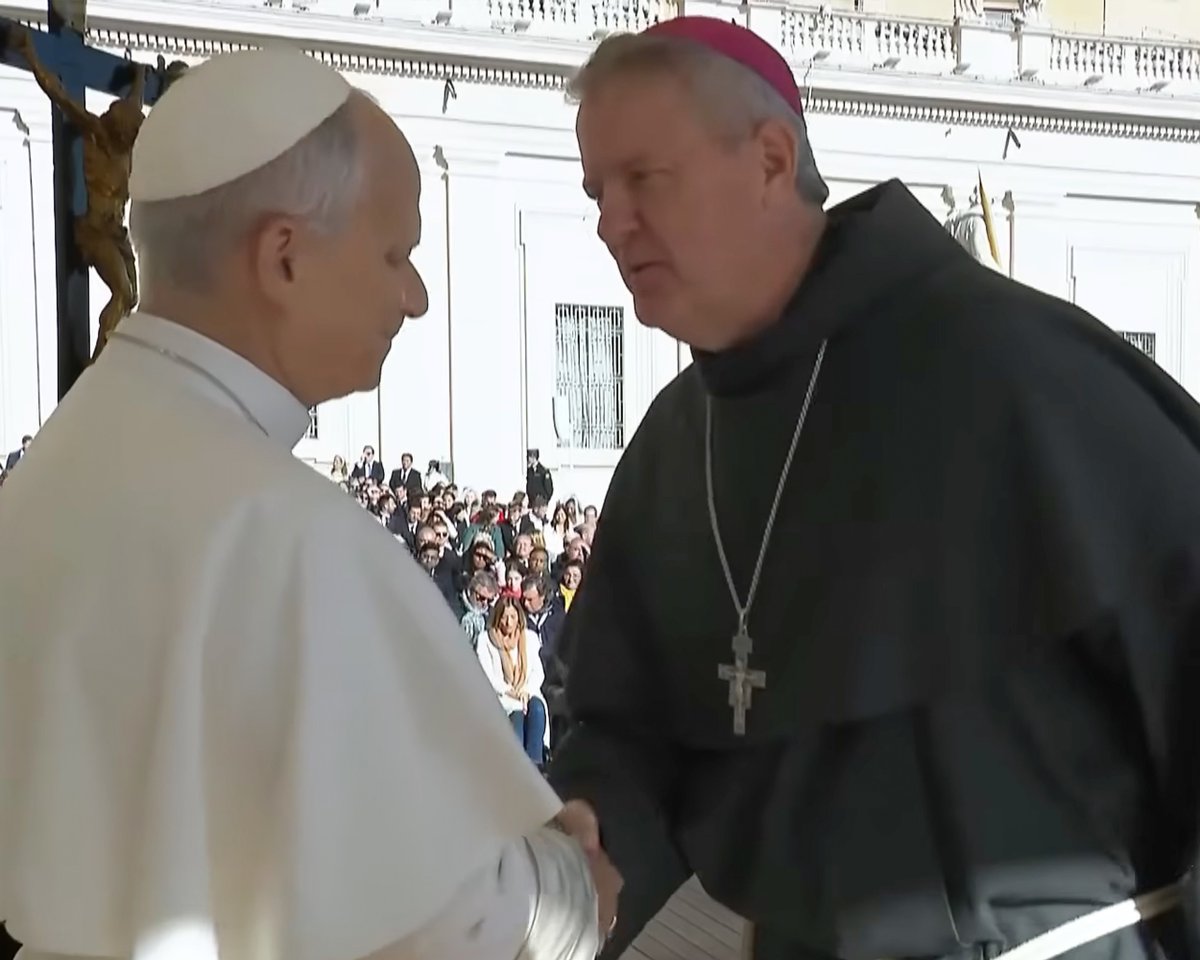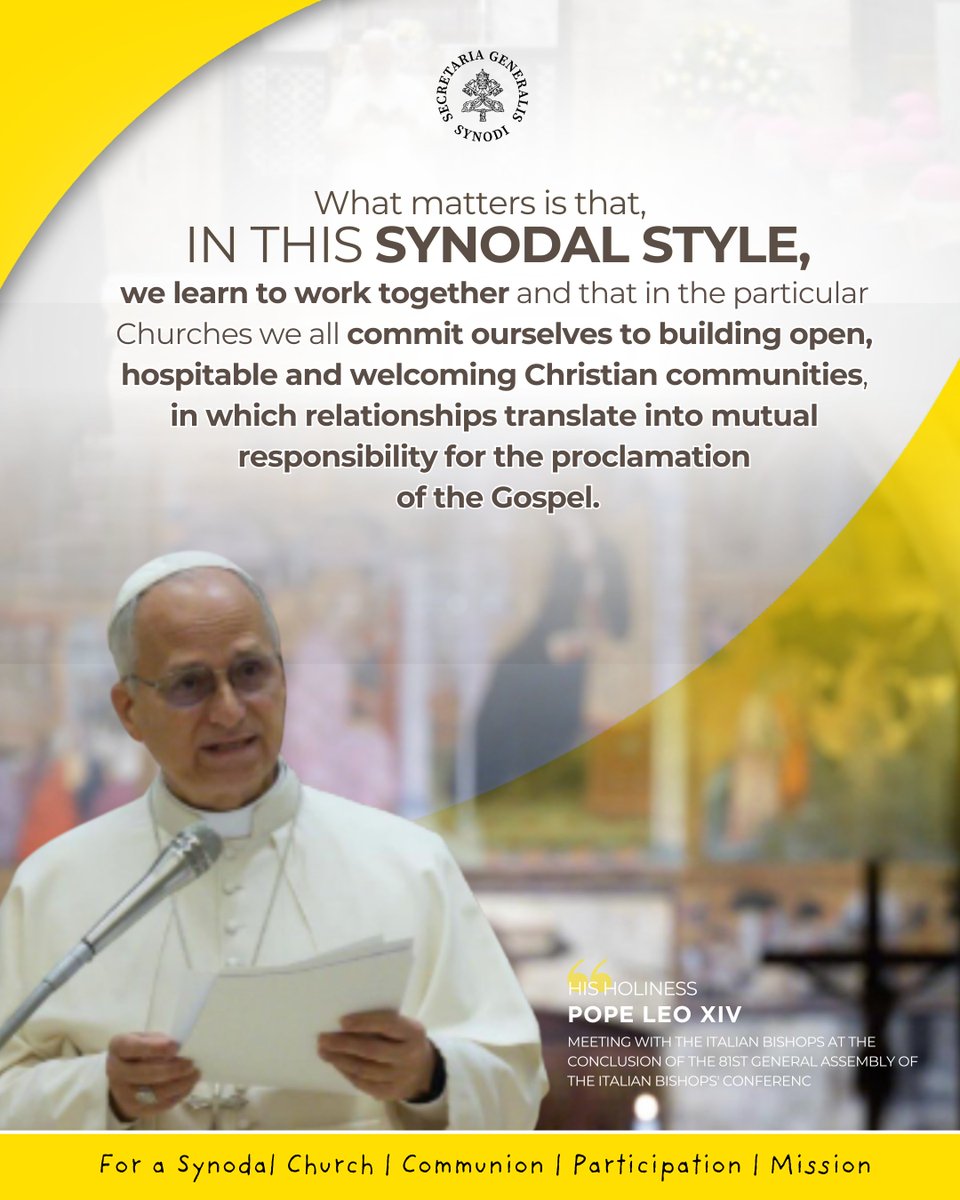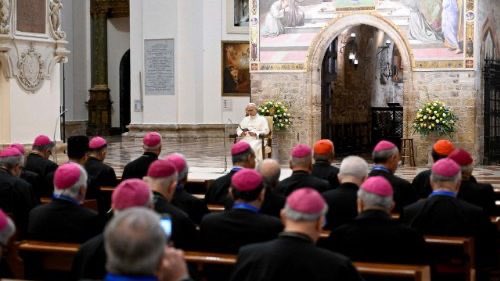Synodality is just getting started….
The Synod is Over, Anything is Possible:
Welcome to the Synodal Church!
 Mash-up of screenshots taken from the Vatican News video feed of the synod’s final congregation.
Mash-up of screenshots taken from the Vatican News video feed of the synod’s final congregation.
The hideous ‘Resurrection’ sculpture by Pericle Fazzini towers over the unholy assembly.
In Vatican City, the much-touted Synod on Synodality — the mother of all synods — finally came to an end this past Sunday, Oct. 27. Not only did the ‘spirit-filled’ assembly in Rome finish its almost four-week deliberations, the entire synodal process begun in 2021 was finally completed. (Originally it was supposed to be done by 2023, but mid-game Francis extended it into 2024, just for the fun of it.)
The participants had spent the last 3-4 weeks ‘walking together’, mostly by sitting around tables, in the Vatican’s creepy Paul VI audience hall. They ‘listened’ and ‘discerned’ like there was no tomorrow, and now this ‘assembly on assembledness’ has produced an all-powerful Final Document, approved by Jorge Bergoglio (‘Pope Francis’) and released on Oct. 26, 2024:
- For a Synodal Church: Communion, Participation, Mission (working English translation)
- Für eine synodale Kirche: Gemeinschaft, Teilhabe und Sendung (working German translation)
- Per una Chiesa sinodale: comunione, partecipazione, missione (Italian original text)
Naturally, this 51-page document is an incredible “gift to the People of God”, as Francis pointed out in his closing speech of Oct. 26. The pro-abortion president of the so-called Central Committee of German Catholics, the extremely feminine Mrs. Irme Stetter-Karp, called Bergoglio’s decision a “small sensation”. At the recgonize-and-resist flagship The Remnant, columnist Robert Morrison is a little less enthusiastic, calling the content of the Final Document “damnable nonsense”.
For those who don’t care to wade through endless gobbledygook about journeys, processes, and communion, the following links provide helpful highlights of the Final Document:
- The Synod on Synodality’s final document: What you need to know (Catholic World Report)
- Synodality: A conversion aimed at becoming more missionary (Vatican News)
- 10 Questions (and Answers) About the Synod on Synodality’s Final Document (National Catholic Register)
- Synod final document: Women, transparency, new ministries (La Croix International)
- Excerpts from the Synod’s Final Document That Offer Hope for LGBTQ+ Inclusion (New Ways Ministry)
- Synodality—and ‘controversial’ issues—are here to stay: Takeaways from the Synod’s final document (America)
- Synod on synodality concludes: these are the 11 most rejected proposals (Zenit)
- Women Deacons, ‘Sexuality’ and More: Here’s How the Synod Final Document Changed From the Draft (National Catholic Register)
Contrary to expectations, the false pope surprised everyone when he declared that he was not going to issue a post-synodal ‘apostolic exhortation’, as would have been the custom. Instead, he said he was simply publishing the entire Final Document ‘as is’, so to speak:
…I do not intend to publish an Apostolic Exhortation, what we have approved is sufficient. There are already highly concrete indications in the Document that can be a guide for the mission of the Churches, in their specific continents and contexts. This is why I am making it immediately available to everyone, it is the reason I said that it should be published. In this way, I wish to recognize the value of the synodal journey accomplished, which by means of this Document I hand over to the holy faithful people of God.”
(Antipope Francis, Final Greeting at 17th General Congregation of Second Session of XVI General Ordinary Assembly of the Synod of Bishops, Vatican.va, Oct. 26, 2024)
It appears that by making this move, Francis tacitly gave a certain magisterial status to the Final Document, in accordance with Article 18 of his ‘Apostolic Constitution’ Episcopalis Communio of Sep. 15, 2018:
- Synod’s Final Document has Magisterial value (Vatican News)
Depending on exactly how this ‘magisterial value’ is to be understood, all who consider themselves Catholic and acknowledge Francis as a true Pope may have to render “religious submission of mind and will” to the Final Document of the Synod on Synodality, at least “as a set of guiding principles”, as noted in the above-linked Vatican News article (cf. Vatican II, Lumen Gentium, n. 25). In his “10 Questions (and Answers) About the Synod on Synodality’s Final Document”, the National Catholic Register‘s senior editor Jonathan Liedl notes, “The fact that a synod body whose membership was 27% non-bishops just produced a magisterial text will certainly leave theologians and canonists with much to talk about.”
A good, somewhat in-depth review of the Synod’s Final Document has been released by The Catholic Esquire, a non-sedevacantist pundit:
It would be quite short-sighted and a grave mistake to think that because the Synod’s Final Document does not call for women’s ordination or similar progressivist aberrations, that therefore “we’ve dodged a bullet” and can move on. Anyone who’s paid close attention these last 11+ years knows that Francis plays the long game if he has to, and although he is already advanced in age, he has been working to ensure that his legacy will continue for at least a generation (for example, through the appointment of bishops and cardinals according to his liking).
In his 2013 ‘apostolic exhortation’ Evangelii Gaudium, the false pontiff laid out, albeit obscurely, his long-term strategy, which he condensed into the idiotic-sounding principle “time is greater than space”:
This principle enables us to work slowly but surely, without being obsessed with immediate results. It helps us patiently to endure difficult and adverse situations, or inevitable changes in our plans. It invites us to accept the tension between fullness and limitation, and to give a priority to time. One of the faults which we occasionally observe in sociopolitical activity is that spaces and power are preferred to time and processes. Giving priority to space means madly attempting to keep everything together in the present, trying to possess all the spaces of power and of self-assertion; it is to crystallize processes and presume to hold them back. Giving priority to time means being concerned about initiating processes rather than possessing spaces. Time governs spaces, illumines them and makes them links in a constantly expanding chain, with no possibility of return. What we need, then, is to give priority to actions which generate new processes in society and engage other persons and groups who can develop them to the point where they bear fruit in significant historical events. Without anxiety, but with clear convictions and tenacity.
(Antipope Francis, Apostolic Exhortation Evangelii Gaudium, n. 223)
In short: Francis isn’t so much concerned with achieving immediate (and perhaps short-lived) results as with kicking off processes that, over time, will deliver the desired results in ways that are fruitful and permanent and thus irreversible. And that is exactly what the Synod on Synodality has done for him.
By the way: For those who are wondering just what synodality is, the Final Document offers the following definition: “In simple and concise terms, synodality is a path of spiritual renewal and structural reform that enables the Church to be more participatory and missionary, so that it can walk with every man and woman, radiating the light of Christ” (n. 28). Considering that that is a “simple and concise” definition, one would hate to come across a more complex and elaborate one.
Synodality itself “has grown from a theological concept into a guiding principle of Church governance” in the last nine years, reports Jonathan Liedl in another article. It all began with a landmark speech Francis gave on Oct. 17, 2015, during a Vatican ceremony commemorating the 50th anniversary of ‘Pope’ Paul VI’s institution of the Synod of Bishops.
The Italian columnist Stefano Fontana, who represents a conservative Novus Ordo position that tends towards recognize-and-resist, observes that the Final Document “does not make clear choices of rupture and at the same time keeps all doors open for the future, in the awareness that the Synod closes but synodality does not.” In other words, the synod may be over, but the synodal process that has now been born, will go on indefinitely. And that process will be the vehicle for all kinds of potential changes down the road. The era of synodality has begun, so that from now on, the ‘holy people of God’ can ‘discern’ what it is the ‘Spirit’ wants for the Church.
Thus Fontana reasons that “what is considered by some to be a step backwards compared to the expected progressive openings, is actually a sign that what is wanted is the synodal process that, without haste, will create a new Church.” Why a new church? Don’t they already have a new church? They most certainly do, but what ‘Pope’ Paul VI called the ‘Conciliar Church’ of Vatican II was perhaps only the first step in the ongoing infernal attempt to demolish Roman Catholicism completely. Besides, the narrative of a new church yet to come is a clever way to subconsciously drive home the point that the Vatican II Church is not itself a new church already, just as all the fuss over the (in)validity of the resignation of Benedict XVI entirely obscures the fact that the man held no papal office from which to resign in the first place.
All kinds of reports, commentaries, analyses, and reflections on the Synod have been published online, good and bad. Hellboy James Martin, for example, says he’s had “conversions at the synod”; Bergoglian propagandist Austen Ivereigh sees the “Church at a turning point”; and ‘Cardinal’ Jean-Claude Hollerich promises Novus Ordo adherents that they “with time will see a Church where they count…”.
Here are smore more:
- Synod’s final report calls for all baptized Catholics to shape future church (National Catholic Reporter)
- Synod final text calls for continued ‘process’ with synodal ‘listening’ and dialogue (Life Site)
- How Francis is changing the Church through the Synod on Synodality (Katholisch.de)
- In the end, Pope Francis steered his synod toward a soft landing (Crux)
- The (surprisingly positive) change toward L.G.B.T.Q. issues at the synod (America)
- Pope Francis closes Synod saying Church needs to ‘get its hands dirty to serve the Lord’ (Life Site)
- EXCLUSIVE: Archbishop Viganò’s reaction to the Synod: ‘Whore of Babylon’ (Life Site)
- Cardinals McElroy, Cupich join Fr. James Martin in praising Synod on Synodality’s final text (Life Site)
- In synod closing Mass, Pope Francis calls for ‘a Church that hears the cry of the world’ (Catholic World Report)
- Pope Francis ‘adopts’ final synodal document (The Pillar)
- Pope Francis ratifies Synod on Synodality’s final document, marking new approach to Church reform (Catholic World Report)
- Good News? Synodal Final Document Proposes “Pentarchy 2.0” (One Peter Five)
- Synod’s final text includes openness to female deacons after draft version’s silence (Life Site)
- African Bishops Pleased With Outcome of Synod, Leading Prelate Says (National Catholic Register)
- Synod: Pope Francis shapes the church of tomorrow (La Croix International)
- The problems and potential of synodality (National Catholic Reporter)
- Synod Issues an Anti-Monarchical Blueprint (Tradition in Action)
One of the more incisive observations about what the Synod has accomplished comes from EWTN’s senior Vatican analyst, Francis X. Rocca:
The Pope has used both the synod and the press to widen the Overton window of acceptable opinion in the Church and hence to stoke debate at its highest levels over issues that only a decade ago were considered settled. Much of that debate promises to continue past the end of the current pontificate. Pope Francis has thus helped to shape his successor’s agenda and bequeathed him, in an expanded conception of synodality, a process with which to address it.
(Francis X. Rocca, “It’s Premature to Judge the Synod Just Yet”, National Catholic Register, Oct. 29, 2024)
The great concluding event for the Synod on Synodality, of course, was the Mass Novus Ordo worship service conducted in St. Peter’s Basilica. In his sermon for the closing liturgy, Francis of course happened to find “an image of of the synodal Church” in the Gospel reading for the day (Mk 10:46-52), and he also gave his followers a new “cry” to be attentive to: “We do not need a sedentary and defeatist Church, but a Church that hears the cry of the world – I wish to say this even if some might be scandalised – a Church that gets its hands dirty in serving.”
By the way: This week, from Oct. 28-30, the Pontifical Gregorian University in Rome hosted an academic symposium at which theologians ‘reflected’ on the reception stage of the Synod on Synodality. Don’t say you weren’t warned!
All in all, we can say: The big Vatican blather circus may be over, but the Modernist revolution just got kicked into higher gear; the Synod may be over, but synodality is just getting started!






No Comments
Be the first to start a conversation